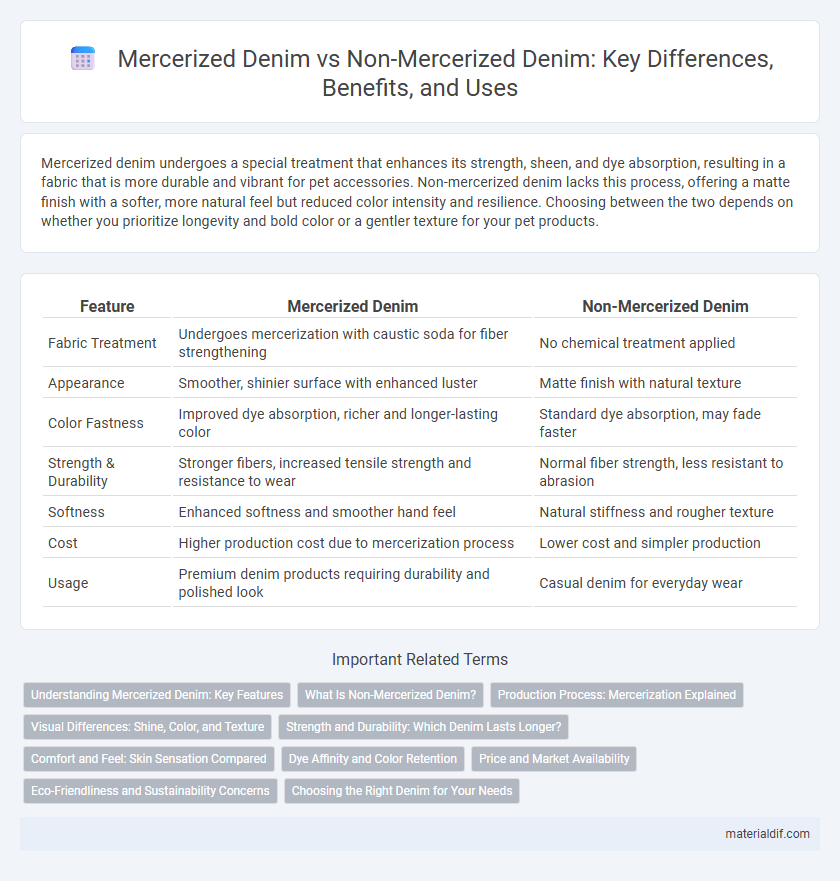Mercerized denim undergoes a special treatment that enhances its strength, sheen, and dye absorption, resulting in a fabric that is more durable and vibrant for pet accessories. Non-mercerized denim lacks this process, offering a matte finish with a softer, more natural feel but reduced color intensity and resilience. Choosing between the two depends on whether you prioritize longevity and bold color or a gentler texture for your pet products.
Table of Comparison
| Feature | Mercerized Denim | Non-Mercerized Denim |
|---|---|---|
| Fabric Treatment | Undergoes mercerization with caustic soda for fiber strengthening | No chemical treatment applied |
| Appearance | Smoother, shinier surface with enhanced luster | Matte finish with natural texture |
| Color Fastness | Improved dye absorption, richer and longer-lasting color | Standard dye absorption, may fade faster |
| Strength & Durability | Stronger fibers, increased tensile strength and resistance to wear | Normal fiber strength, less resistant to abrasion |
| Softness | Enhanced softness and smoother hand feel | Natural stiffness and rougher texture |
| Cost | Higher production cost due to mercerization process | Lower cost and simpler production |
| Usage | Premium denim products requiring durability and polished look | Casual denim for everyday wear |
Understanding Mercerized Denim: Key Features
Mercerized denim undergoes a chemical treatment with sodium hydroxide that enhances fiber strength, luster, and dye affinity, resulting in richer color vibrancy and improved durability. This process also reduces fabric shrinkage and increases softness, making mercerized denim preferred for premium-quality garments. Non-mercerized denim lacks these enhancements, often appearing duller and less resistant to wear and fading over time.
What Is Non-Mercerized Denim?
Non-mercerized denim is fabric made from raw cotton fibers that have not undergone the mercerization process, retaining a more natural, matte finish and less luster compared to mercerized denim. This type of denim typically exhibits greater breathability and a softer hand feel, but it may have less strength and color vibrancy than mercerized alternatives. Non-mercerized denim is favored for its authentic texture and traditional appearance in vintage-style jeans and denim products.
Production Process: Mercerization Explained
Mercerized denim undergoes a chemical treatment with sodium hydroxide, which causes cotton fibers to swell, resulting in increased strength, luster, and dye absorption. The mercerization process aligns the cellulose molecules, enhancing the fabric's smoothness and making the colors more vibrant and long-lasting compared to non-mercerized denim. Non-mercerized denim skips this alkaline treatment, leading to a rougher texture and less intense color retention during washing and wear.
Visual Differences: Shine, Color, and Texture
Mercerized denim exhibits a noticeable sheen due to the mercerization process, which enhances fiber smoothness and light reflection, setting it apart from the matte finish of non-mercerized denim. The color of mercerized denim tends to be richer and more vibrant, with greater depth and uniformity in indigo dye absorption. Texturally, mercerized denim feels smoother and softer to the touch, whereas non-mercerized denim retains a coarser, more traditional denim hand.
Strength and Durability: Which Denim Lasts Longer?
Mercerized denim undergoes a chemical treatment that strengthens the cotton fibers, resulting in enhanced tensile strength and durability compared to non-mercerized denim. The mercerization process reduces fiber fuzziness and increases resistance to wear and tear, allowing garments to maintain their structural integrity over prolonged use. Non-mercerized denim, lacking this treatment, tends to degrade faster due to weaker fiber cohesion and greater susceptibility to abrasion.
Comfort and Feel: Skin Sensation Compared
Mercerized denim undergoes a chemical treatment that strengthens fibers, resulting in a smoother and silkier texture compared to non-mercerized denim, which retains a coarser, more rugged feel. The enhanced softness of mercerized denim improves skin comfort, making it less prone to irritation and more breathable during extended wear. In contrast, non-mercerized denim provides a traditional, stiff sensation that may initially feel rough but typically softens over time with repeated washing and use.
Dye Affinity and Color Retention
Mercerized denim exhibits superior dye affinity due to the alkaline treatment that increases fiber absorbency, resulting in deeper, more vibrant color penetration. This process enhances color retention, making mercerized denim more resistant to fading through washes and exposure to sunlight compared to non-mercerized denim. Non-mercerized denim, with its untreated cotton fibers, tends to absorb dye less effectively, leading to quicker color fading and a more washed-out appearance over time.
Price and Market Availability
Mercerized denim, treated with a specialized caustic soda process, offers enhanced strength, a lustrous finish, and vibrant color retention, commanding higher prices in the premium denim market. Non-mercerized denim remains more affordable and widely available, appealing to budget-conscious consumers and mass-market apparel brands. Market availability of mercerized denim is limited to niche segments and specialty retailers, while non-mercerized denim dominates large-scale production and mainstream retail channels.
Eco-Friendliness and Sustainability Concerns
Mercerized denim undergoes a chemical treatment that enhances fabric strength and sheen but involves intensive water and energy consumption, raising eco-friendliness concerns compared to non-mercerized denim. Non-mercerized denim maintains a more natural production process with lower environmental impact, supporting sustainability efforts by reducing chemical use and wastewater generation. Choosing non-mercerized denim aligns better with eco-conscious fashion brands striving to minimize resource depletion and promote sustainable textile manufacturing.
Choosing the Right Denim for Your Needs
Mercerized denim offers enhanced strength, superior dye absorption, and a smooth finish, making it ideal for high-quality garments requiring durability and vibrant color retention. Non-mercerized denim, while more affordable, retains a rougher texture and may fade faster, suiting casual or budget-friendly fashion needs. Choosing the right denim depends on the desired balance between durability, color richness, and cost efficiency for your specific apparel project.
Mercerized Denim vs Non-Mercerized Denim Infographic

 materialdif.com
materialdif.com